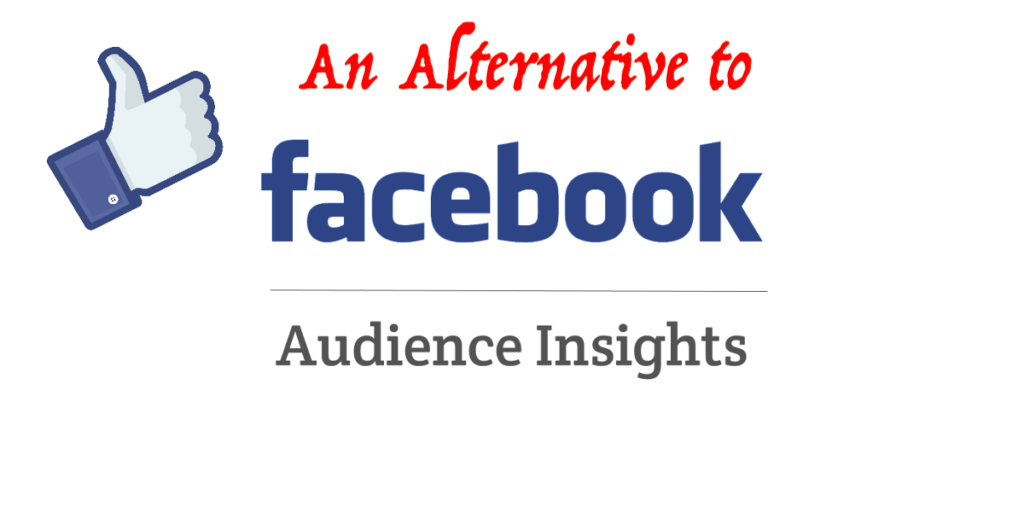
Do you use Audience Insights? Wondering what you would do if Facebook took this powerful targeting tool away?
In this article, you’ll discover strategies to adjust your audience targeting in response to canceling the Facebook audience insight tool after June of this year.
Be sure to read my last blog How Empathy Generates Revenue.
At A Glance
∎ Audience Insights Is Going Away After June 2021
∎ Harness The Power of Amazon & Google For Facebook Targeting
∎ Learn How To ID Your Client Avatar Via Auto Suggestions
Why Audience Insights Is A Crucial Tool for Marketers
Audience Insights provides incredible targeting options for marketers using Facebook ads.
You can use Audience Insights to discover detailed demographics beyond what Ads Manager provides. For example you can enter a Facebook Business Page of one of your competitors and see what the top professions are of those who like their page.
Through the Page Affinity data you can also see related Pages fans of your competitor’s Facebook Page also like. Or dial down even further and you’ll see their education level and relationship status.
I looked up the audience for Tony Robbins fans and here’s an example of the targeting data Audience Insights provides on the Demographics tab:
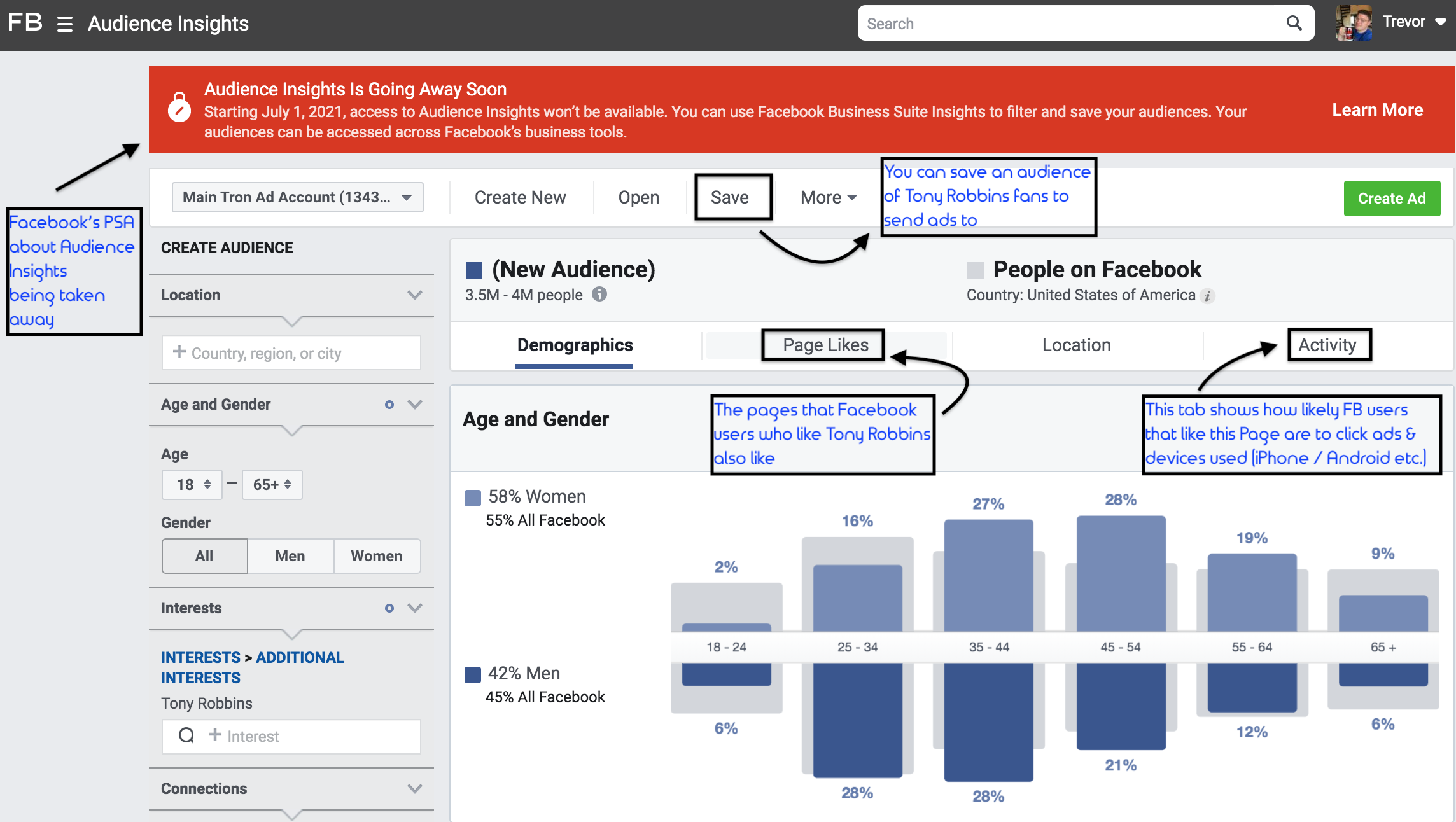
Note: My blog assumes you’re familiar with setting up Custom Audiences and have run ads. For step-by-step instructions check out this article.
Perhaps you’re running ads for a jeweler who makes engagement rings and class rings.
There are even options to check if a Facebook user has graduated college or is about to get married. This helps refine Facebook ad targeting down to a science, matching your offer with your audience.
Having an issue with Facebook dropping the ban hammer down? As Tony Robbins' marketing team found out when I helped them get compliant, it's about knowing how the automations work. Schedule a free discovery call with me here.
Let’s say you’re running ads trying to target people who work in management or finance who are interested in self-help. Scrolling down further beneath relationship and education, you’ll see the top professions in this audience.
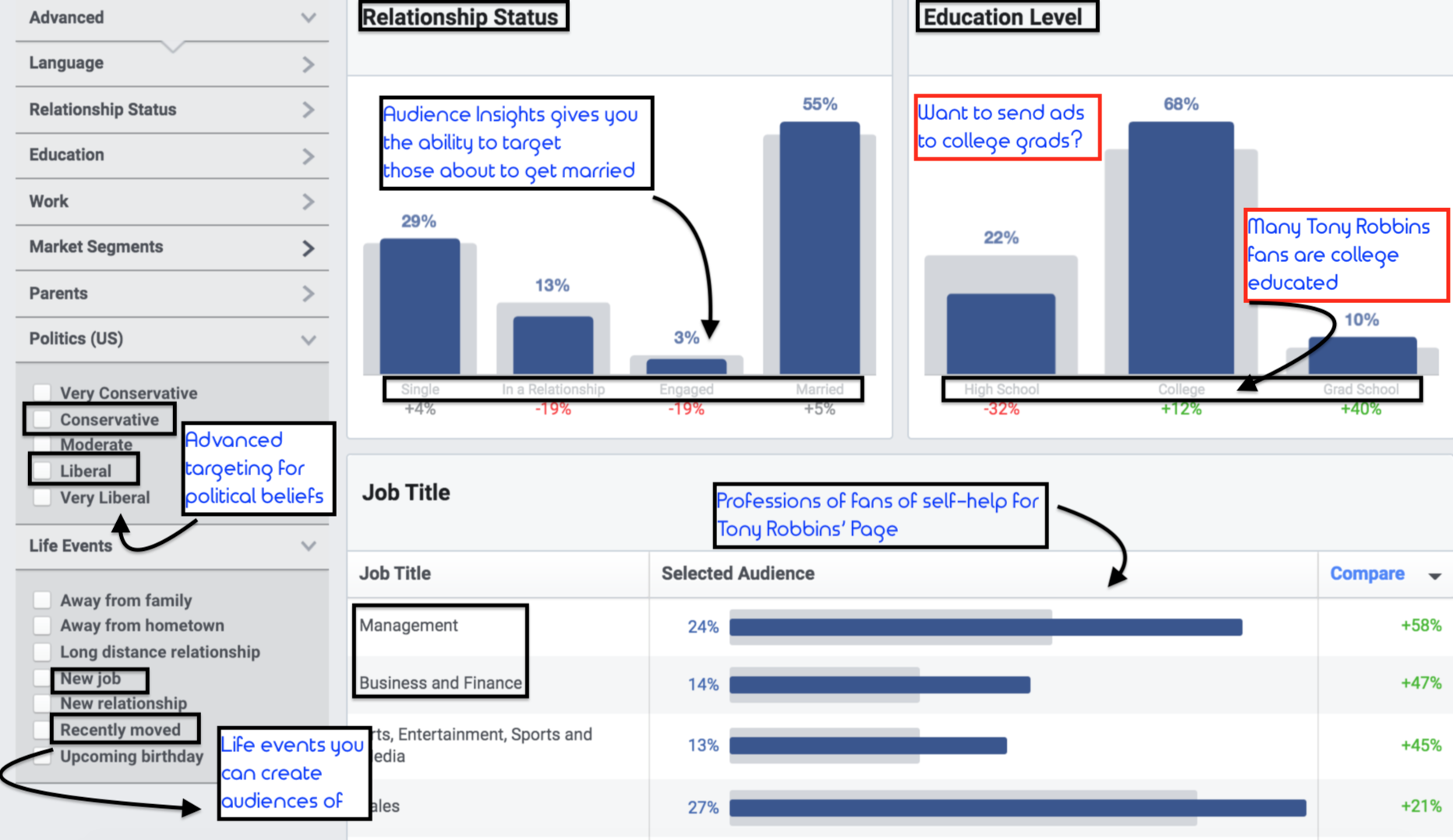
On the Page Likes you can see related Pages sorted by affinity. On the Activity Tab you’ll see how likely Facebook users are to click ads for online purchases.
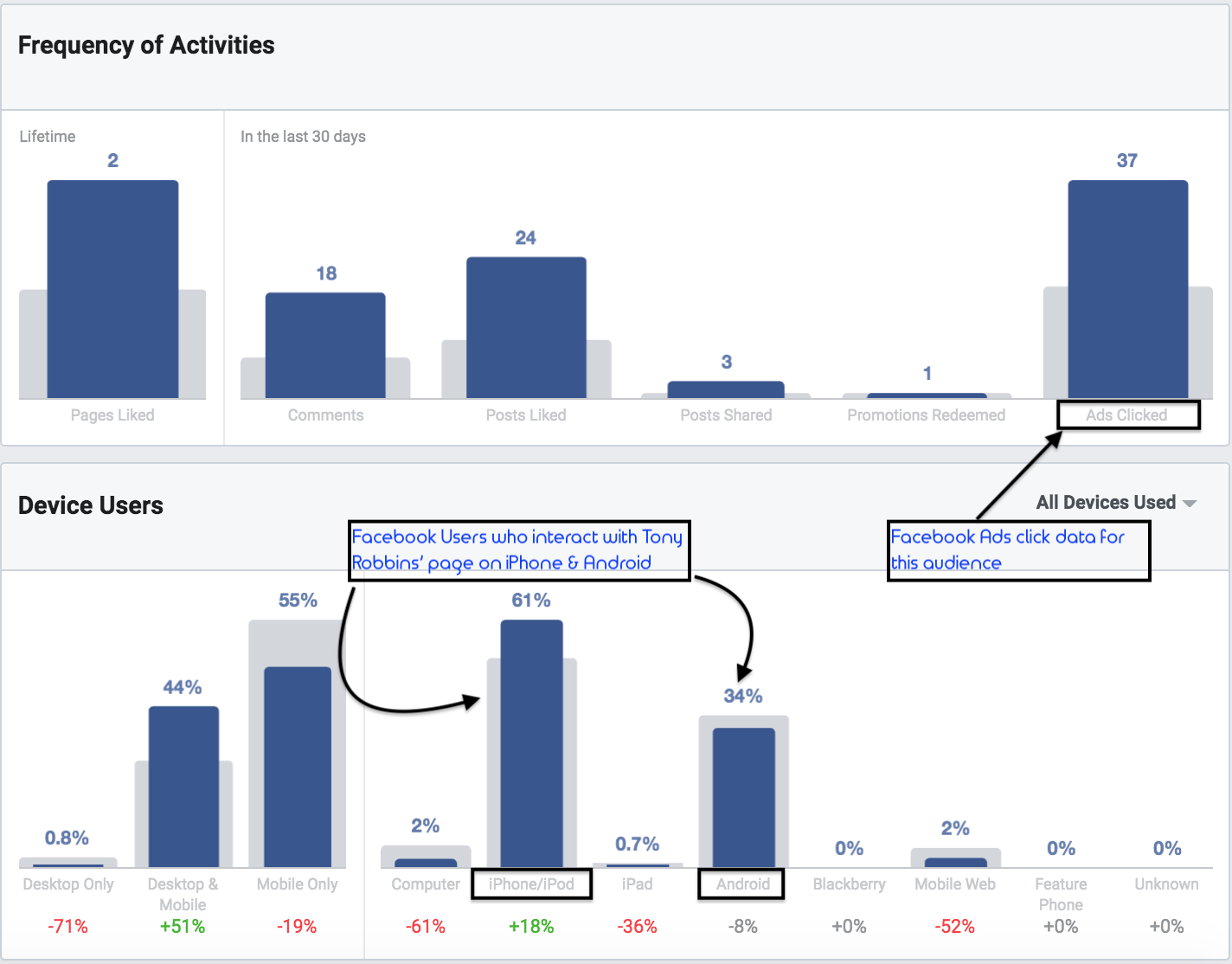
Once you’ve done your marketing detective work and decided this is a good fit you can save this audience. You’ll want to look at segments of the audience to see how to make the best use of this data.
For example, you can create an ad targeted towards married couples 35 to 44 who are college educated like Tony Robbins. You may want to run an AB test to see what demographics respond better using android versus iPhone and/or split test genders.
Facebook Replaces Audience Insights With Business Suite
Facebook has announced that Audience Insights is going away June 30th this year. In Transitioning from Audience Insights to Business Suite Insights Facebook states:
“Audience Insights will no longer be available starting July 1, 2021. Instead, we encourage people to use Facebook Business Suite Insights, which is a tool that allows you to access your audience insights across Facebook and Instagram. In addition to audience data, you will also be able to view trends and metrics on the performance of your Facebook Page and Instagram business profile.
The audience insights you will be able to view include:
- Page Likes (Facebook only)
- Followers (Instagram only)
- Age
- Gender
- Top Cities and Countries
- Location
- Interests
In addition to viewing your audience insights, you’ll be able to filter and save audiences to use in Ads Manager. You’ll also want to make sure you’re logged in to your business account before accessing Business Suite.”
Facebook Business Suite offers the advantages of being able to see your Instagram metrics and Facebook Page metrics in the same place. Business Suite’s new features include one inbox for replying to messages from your Facebook page, Facebook Messenger, and Instagram account.

If you have Business Suite now, you’ll save time in your content strategy with the ability to schedule Stories ahead of time on Facebook and Instagram.
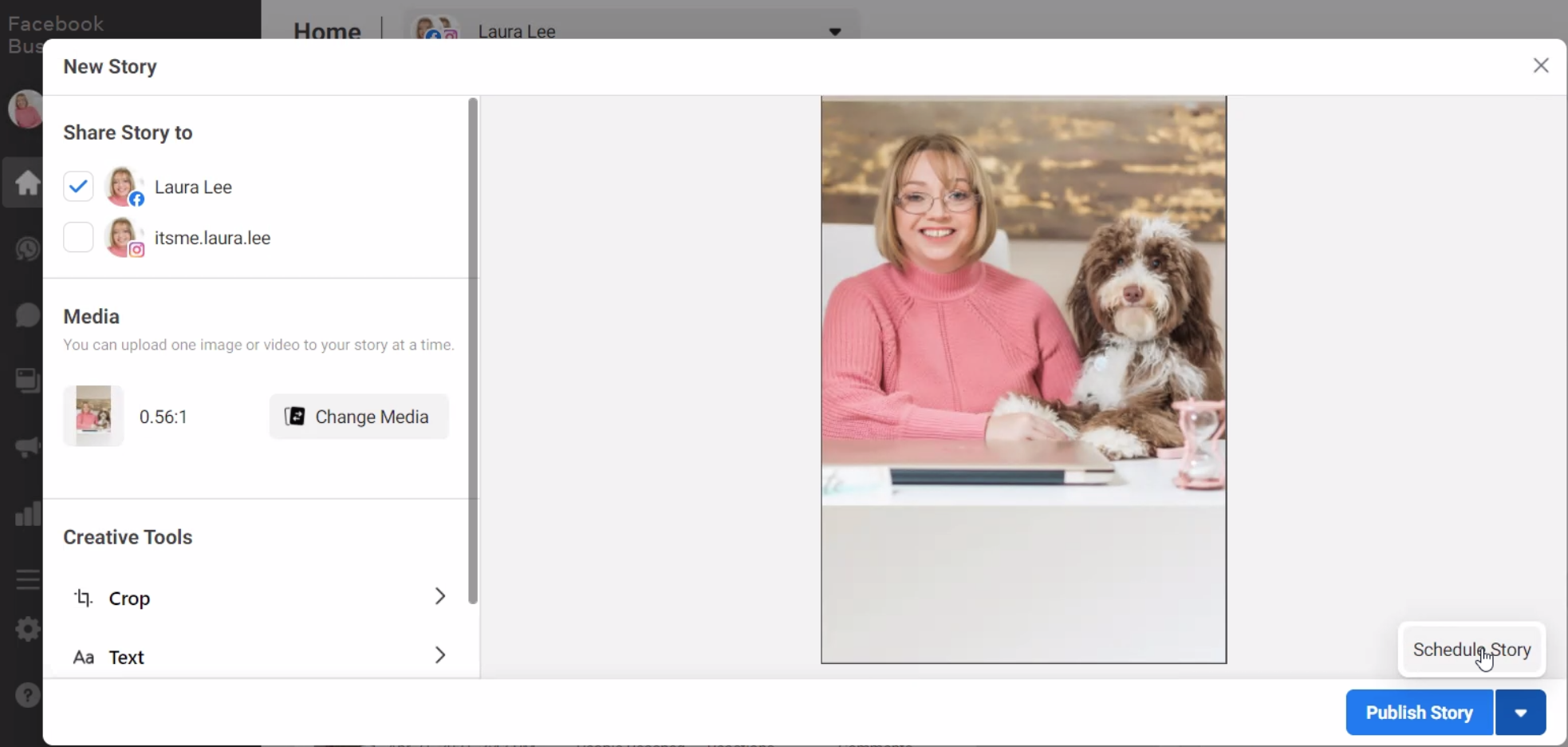
However, a big distinction is these are insights only from your own Pages, not insights you can scope out from your competitor’s Pages. Hence the lack of capitalization of ‘audience insights’ here.
Keep reading for some helpful strategies you can use once the Facebook Insights officially goes away.
As with many new features, Facebook will roll out access to Business Suite to a select number of beta users first before everyone gets access. Hopefully Facebook rolls out scheduling abilities in the API too so our preferred 3rd party tools can do this as well.
To find out more about how Business Suite works read this article.
Is this the end of refining audiences to resonate with your Facebook ads? Not at all. It’s time to design strategies that subniche your ads to more responsive Facebook users.
How To Create Highly Targeted Audiences When Audience Insights Is Taken Away
You may be feeling like things aren’t as relevant as they once were with Audience Insights going away.
And I hear you but here’s what your goal is:
You’re going to do more research than your competitors - which means you’ll find those diamond in the rough audience segments that convert higher that your competitors are ignoring.
This will allow you to market to them a lot cheaper because your competitors are just focusing on larger less targeted niches.
So How Do You Replace Audience Insights
The first rule of thumb when creating an audience is to define who your client avatar is, because if you are targeting everyone then you’re targeting no one. What your ad copy, ad creative and landing page say must resonate with the identity of your client avatar.
If you’re targeting football fans with golf club ads – don’t expect a windfall. We’ve all seen ads that made us question why we saw them if these ads don’t match our interests.
Customization is everything now and that’s what you’ll aim for when creating your audience: ads that are customized to your potential buyers, speaking to their wants and needs.
But that’s not all – in order to create a customer profile we have to verify it is one we can target on Facebook. You can have the best client avatar in the world but if it isn’t one that Facebook recognizes then you risk throwing money at ads that won’t perform.
To vet your client avatar you’ll do market research both off and on Facebook, then use Facebook’s interest-based targeting tools to subniche your audience.
Here are some strategies you can use to refine audiences that will respond to Facebook ad campaigns after the Audience Insights is replaced with Business Suite.
#1: How To Design The Perfect Client Avatar
In order to find the diehard fans that do things lukewarm fans won’t you’ll benefit from studying where these people show up aside from social media.
This means googling top conferences, magazines, blogs and authority figures for your vertical.
The genius of a refined client avatar is you’ll be able to more reliably predict how they’ll react to ads. This increases your ROI and reduces the cost of CPAs on Facebook ads.
While there is always a pay-to-play element when marketing on Facebook, if you are getting good responses, Facebook’s algorithm will make it cheaper to distribute your content on the platform.
The more Facebook users like and engage with content they see on the platform, the more they’ll stay on Facebook.
This is a win-win for Facebook since they make profit off of every user the longer they stay on their site. That’s why ads with more engagement are rewarded with organic traffic in addition to the clicks you’re paying for.
Answer These Questions To Create Your Client Avatar
Think about the type of person who will buy your product or service.
- What keeps them up at night?
- What car do they drive?
What do only they understand that no one else does that they wish other people knew to relate and understand their pain?
Once you’ve answered these questions, link the transformation your product or service offers to solving these pain points. Learn how to define the pain points of your ideal audience and you can write ad copy that converts.
A Day in The Life of Your Avatar
Create an imaginary day in your avatar’s life.
- What car do they drive?
- What restaurant do they eat at?
- What is their family like at home?
- What kind of job do they have?
- What is their favorite Netflix series?
- What are their favorite magazines, blogs, websites, celebrities, and Facebook Pages?
Who are the authority figures in this vertical? Who are the thought leaders? What are big brands in my niche? These are all questions you’ll want to answer when building the profile for your perfect customer.
You want to go down deeper and think about:
- Okay where does my target audience live?
Figure out what parts of the world or what parts of the United States have the most amount of people in your specific niche. Find out what tools your niche uses too. Find the Facebook Pages for these tools and see how your audience interacts.
- What sort of tools do businesses advertising to your audience sell?
- What do they use? What’s specifically unique about this group?
Once you answer these questions you can figure out who your target audience is and what transformation you’re going to offer this audience.
Perhaps you want to target folks who have recently moved and are seeing a lot of new changes in their life. Think about what kind of transformation they’ll have after buying your product or service.
Also Ads Manager’s interest-based targeting fields does offer many of the same targeting fields going away with Audience Insights such as life events.
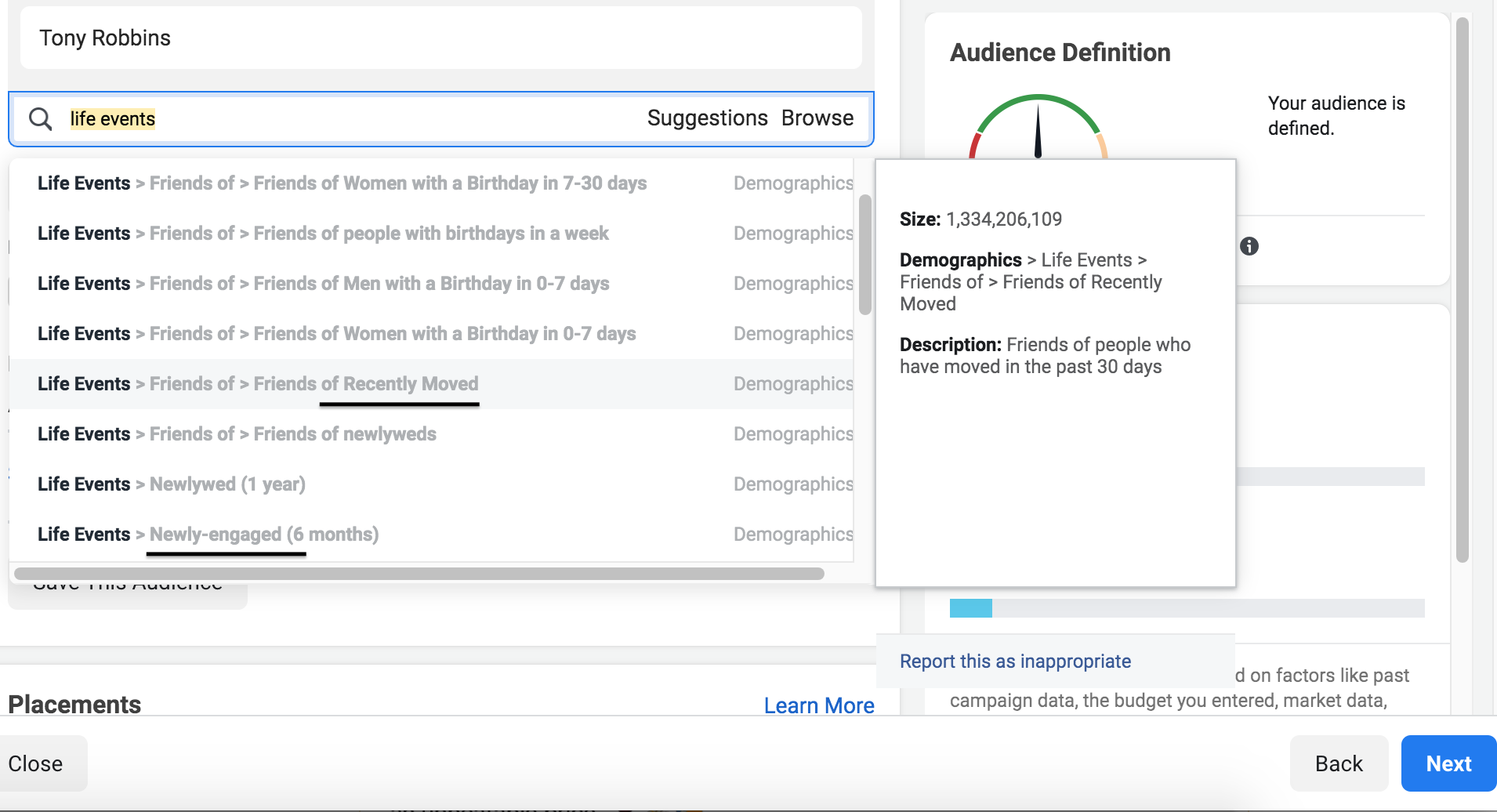
Creating a day in the life of your avatar is all about defining the emotions of your customers and identifying their lifestyle.
Here’s the deal: you can’t just come up with an idea and then sell it. I wish it were that easy - but it’s not. Everyone wants to be sold on something not from a logical level, but from an emotional level.
So do more ad detective work and ask, “Ok, what are they feeling?”
They’re feeling like, “I wish I had a solution to this problem in my life.”
Once you brainstorm the feelings of potential customers you’ll have a better handle on the type of words they use to describe their pain points. Ever heard a friend complain about a service they subscribe to or something they wish was better that isn’t?
Take notes, this is customer feedback. Your audience has the same conversations with their friends. Your job is to find out what conversations your customers are having, predict their pain points and offer a solution.
Reframe how you think about your future customers in this way and that will help you craft a marketing message that resonates with your audience.
Protip: Don't create a product & try to sell it to people. Find out what people want, create that, and sell it to them. This ensures they will buy what you're selling. You’ll figure this out through market research.
#2: Harness The Power of Google to Subniche Your Audience
Google the top blogs, magazines and gurus in your niche. One of the best ways to find out what's trending is to google the top books in your market.
Make a list of the author's names, and the keywords you see popping up again and again on Amazon, Google, and Facebook.
What do you see?
You'll notice patterns emerge for the top books in your niche last year and this year. The best selling authors are circling around specific topics that your target audience is interested in.
These topics won't come up with frequency and regularity in a google search for pain points because market research goes deeper than just pain points.
If you ever feel stuck coming up with key terms to research remember to take advantage of Google’s autocomplete for searches. I’m going to continue using Tony Robbins for the sake of consistency and his field of self-help.
Googling top books in self-help we can see the other search terms this audience uses:
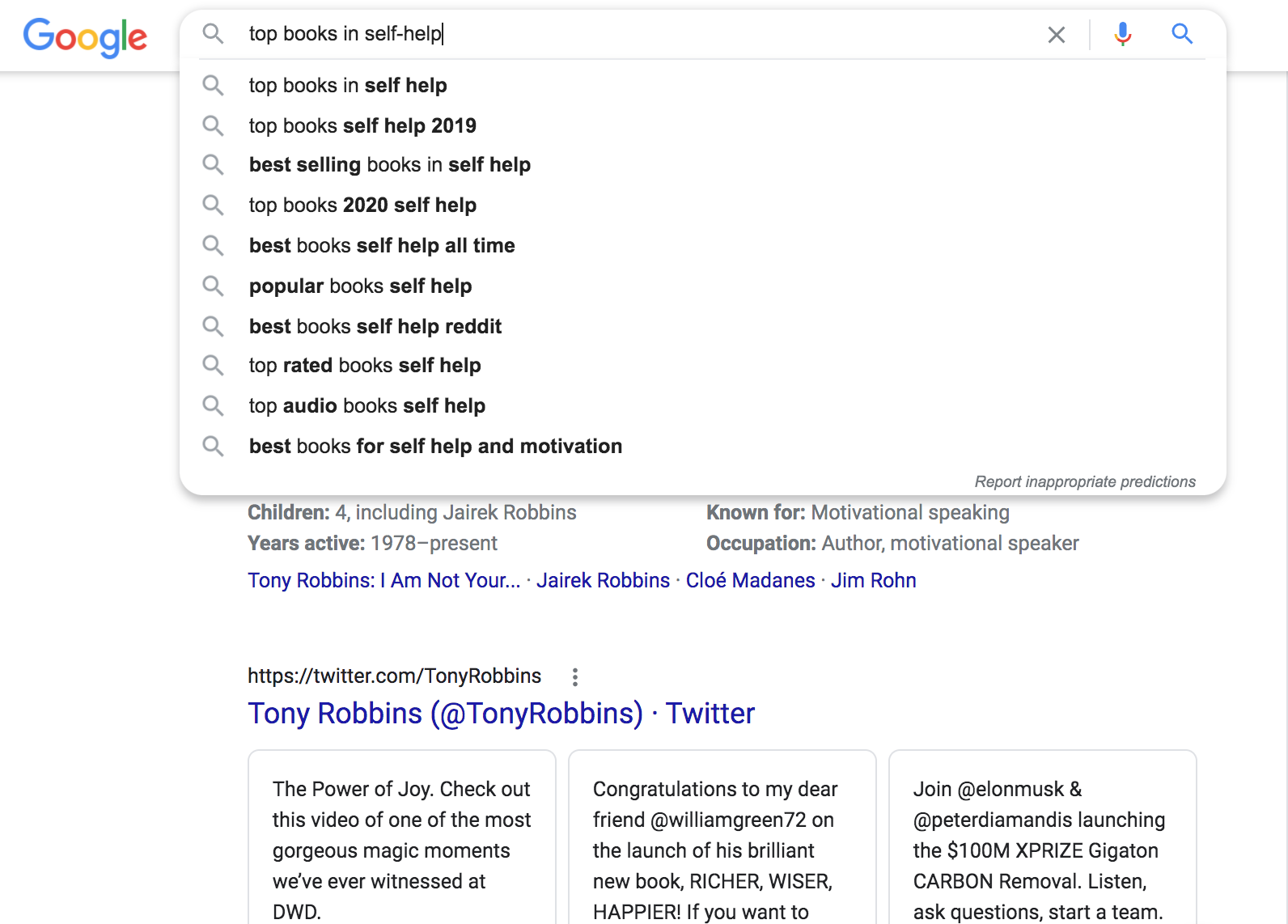
The top books in your niche are going to describe the world through your target audience's eyes and the language they use in addition to pain points. You can also learn what they consider as a win.
When you talk about the specific wins your client avatar has and learn how they define success - this empowers you to create a product or service that offers a meaningful transformation beyond just solving pain points.
You’ve created a much better customer profile now.
The next step is to segment your target audience into a subniche after familiarizing yourself with their wins and barriers.
Sub Niche Your Client Avatar
Let’s say you want to target someone with a weight loss ad for a high ticket fitness program. You may want to start by researching professions that are sedentary but also high paying. Office jobs are pretty sedentary, but not everyone who works in an office can afford a high ticket offer.
You’ll sub niche further to find who that ideal customer is. A quick google search of the top paying office jobs reveals information technology managers, investment fund managers and actuaries are all good candidates.
Now you can create an ad that hits on the pain points of working in tech and wanting to get in shape. (Make sure to follow Facebook’s personal attributes policies here).
Imagine you saw an ad that uses familiar phrases and expressions you often say at the water cooler (or in Zoom meetings these days).
You’d probably click on that ad versus one that sounded unfamiliar right?
Becoming fluent in your client avatar's language is how you increase your marketing conversions. Using the same words your audience does paints a more complete picture of the transformation your product or service offers.
This levels up your ability to craft your marketing message, establish your positioning in the market as an expert, and improve your rate of return when selling your product or service through Facebook ads.
Google Custom Intent Audiences
You can also use Google’s Affinity or Custom Intent audiences for PPC ads or YouTube ads. This lets you make your own affinity audience using interests, URLs, and places.
You’ll be able to target people in the market for a particular product or service. They’ve googled a keyword or phrase in the past 14 days.
Life events: These are audiences that have moved recently, bought a home, gotten engaged, have a birthday this month and more.
Custom intent audience: Add at least 50 researched keywords to set up a custom intent audience.
Google will then try to show your ads to people who are searching for these keywords. Read this article for more information.
Virtual Summits & Conferences
While googling top books, magazines and blogs in your niche is great for crafting your audience profile, virtual summits and conferences add an extra level of depth.
Google top conferences or virtual summits in your niche to start uncovering the language your audience uses. Staying with the self-help example, I googled top self-help conferences.
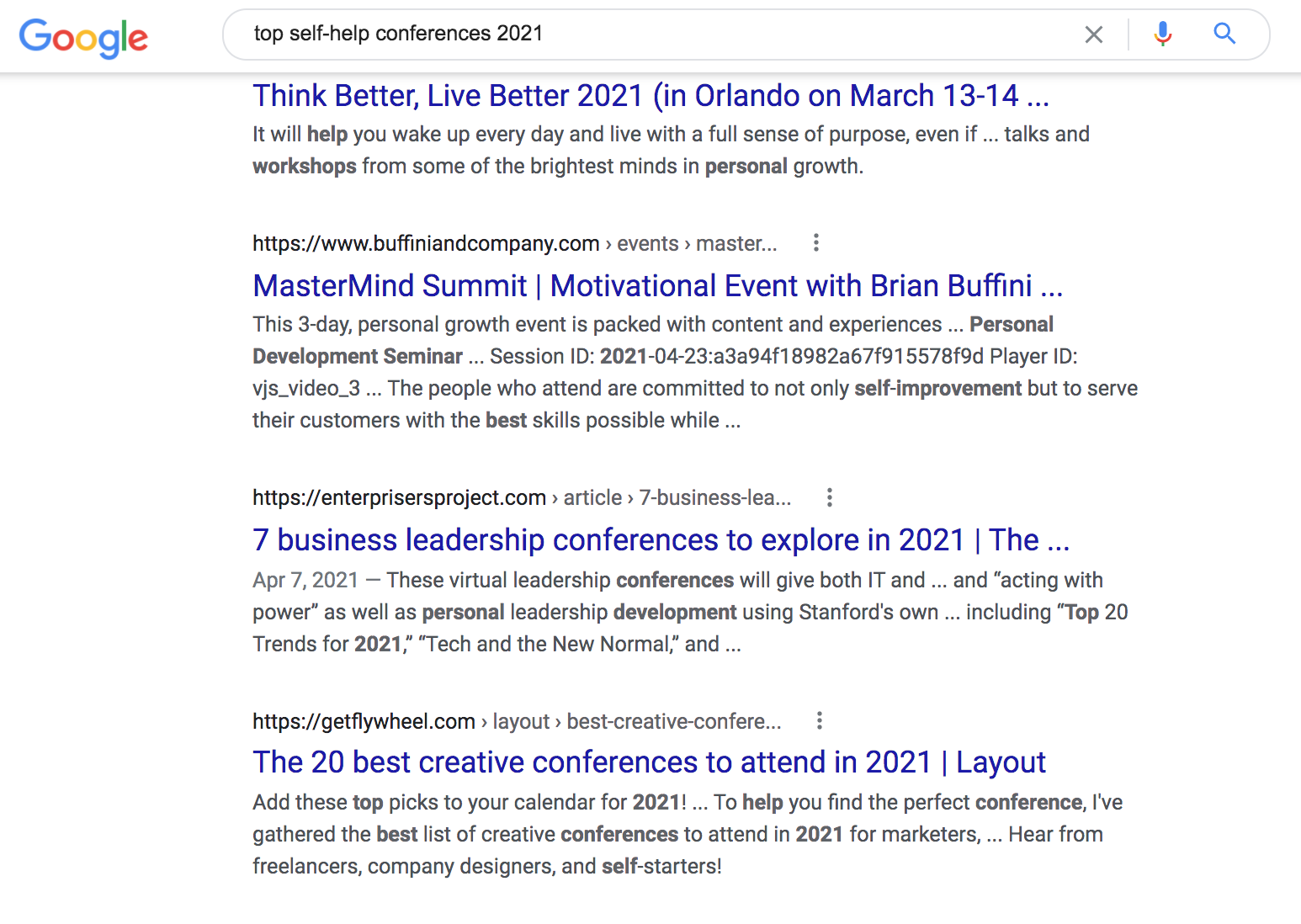
This is a gold mine for understanding even deeper than books what your niche wants and needs.
You'll see a Who's Who of the trending book authors (there will be a small bit of overlap) that are also slated to speak at major conferences - this may be a virtual event given the current times.
Many book authors can have a best selling book but still aren’t trending in your market.
The number one way to find out the hottest topics your ideal avatar is interested in, obsess over and can't stop talking about is to find the experts in their field who are actively speaking this year at virtual summits and conferences.
This is the definition of trending, as these experts will also be doing interviews on news stations, talk shows like the Tonight Show and public appearances.
After you've googled "top [niche name] conferences [current year]" or "top [niche name] virtual summits [current year] look at the talking points the major speakers are bringing up.
Jot these points down as they are keywords you’ll want to use in Facebook interest targeting as well as Amazon market research.
Look Into Conference Demographics
The people attending conferences top experts are speaking at are going to be your target audience or related to your target audience. These attendees are going to be a good indicator of what your avatar is interested in right now.
You may even want to attend a few conferences virtually or in person (socially-distanced). Attending a virtual summit will be a great opportunity to survey your audience and make new connections to increase your business and potential cash flow.
#3: Cross Reference Amazon Kindle Best Seller Lists With Facebook Interests To Find The Best Audience
Look on Amazon for the best selling books in your niche. Now read the reviews.
What testimonials are being given about this niche’s expert advice? What transformation is being described?
Can you offer this kind of transformation with your product or service? How? What are their customers complaining about that you can solve?
Answer these queries and you will be super charged to define your target avatar’s wants and needs. You’ll know what keeps them up at night and have a solution to their biggest problems. Now it’s time to harness the power of Facebook’s suggestions.
We’re going to be testing on the fly using Facebook’s auto-populate recommendations but cross-referencing them to authenticate these interests as valid targeting parameters for your audience.
You’ll see there are a list of related interests that Facebook auto-recommends when I type in Tony Robbins and click on “Suggestions.”
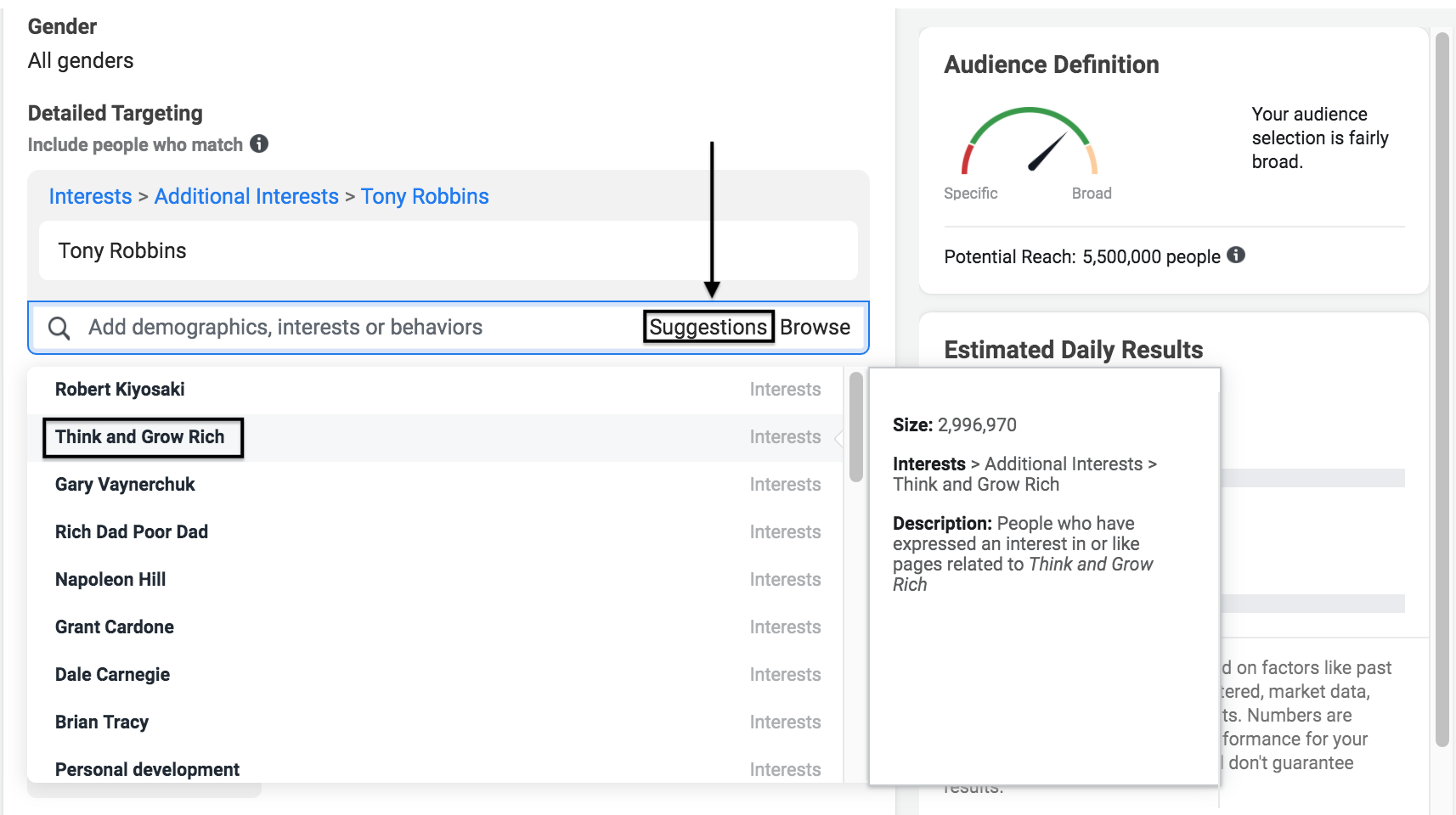
Facebook suggests Think and Grow Rich here for self-help meets build-a-business space. This is how you can explore interests you may not have known about before, discover overlapping fields and refine your targeting.
I can click on Think and Grow Rich then remove Tony Robbins from the targeting field.
Now I’m seeing Facebook’s suggestions for Think and Grow Rich. I select the 4-Hour Workweek by Tim Ferris and remove Think and Grow Rich. You can keep doing this to find new audiences.
This is important because a lot of marketers are targeting fans of Tony Robbins so there’s a lot of competition in this space.
Increased competition for the same audience is what drives up the cost of ads on Facebook (as you may have noticed during holiday seasons).
You can use this process to find smaller markets that are relevant to your target audience. It’s all about those who do more market research and find more distinctive interests that fewer advertisers are bidding on.
These marketers have a higher chance of getting lower cost-per-click (CPC), lower cost per conversion and more conversion rates because there’s less competition in that ad auction targeting these people.
That’s the power of refining your targeting to a subniche rather than a larger general niche.
Amazon Kindle Best Seller Lists
Now it’s time to combine the power of Amazon, Facebook and Google together to narrow your target audience. Sticking with the self-help theme, next I’ll google best selling eBooks on Amazon.
Look for the Amazon Kindle best selling books page that appears on Google - it’s a great market research tool.

Now you’ve got your main categories, but it’s time to subniche down to another category like self-help for Tony Robbins fans.

You want your audience highly targeted right? Self-help is a big field, but if you look at Tony Robbins’ events and books, transformation is a keyword. Subniche down one level further to Personal Transformation.
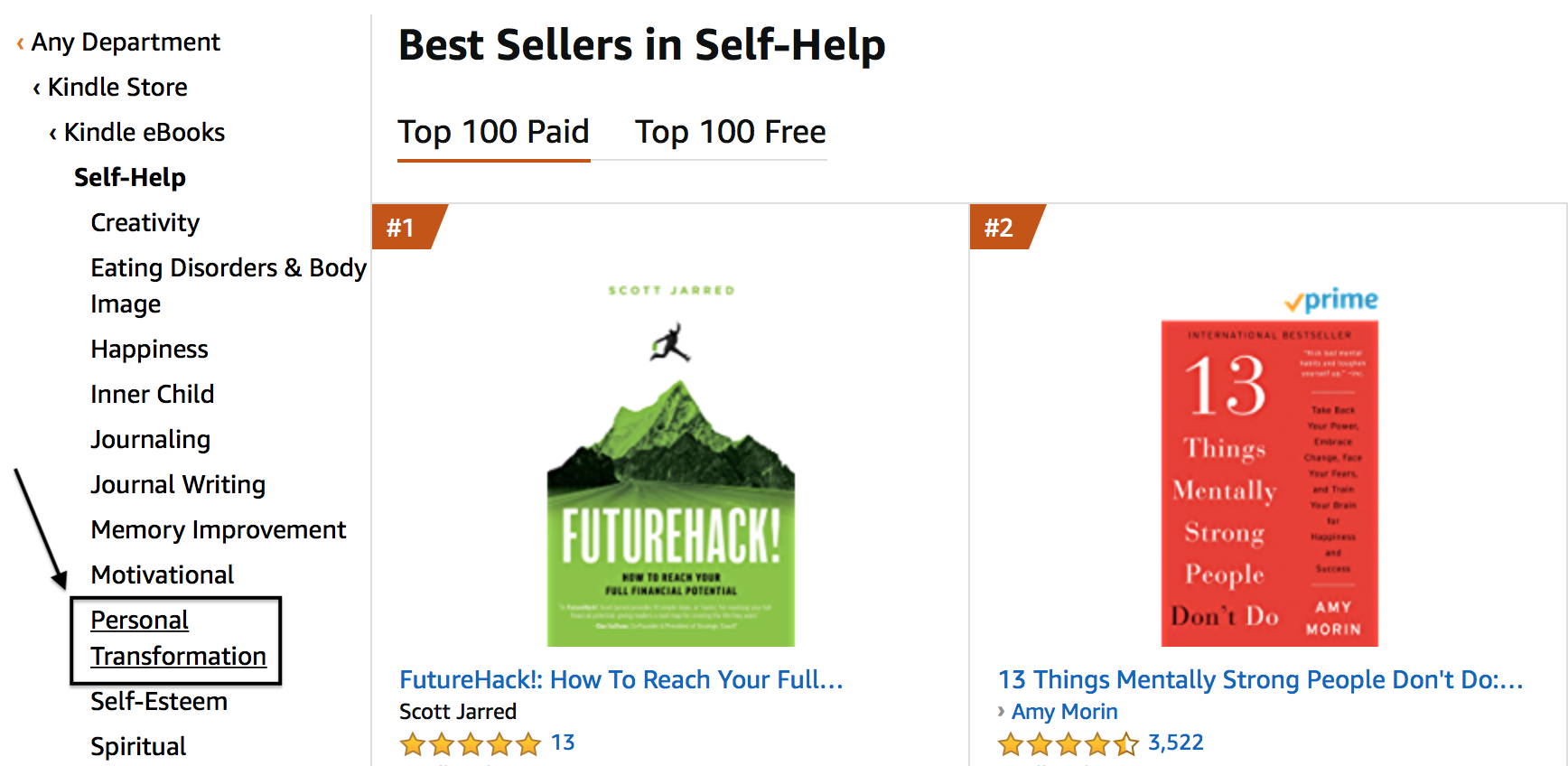
The idea is you want to keep subniching down until you get to the bottom category, which we are at right now with Personal Transformation. I have the top fifty here on this page if you scroll down. The top six appear first.
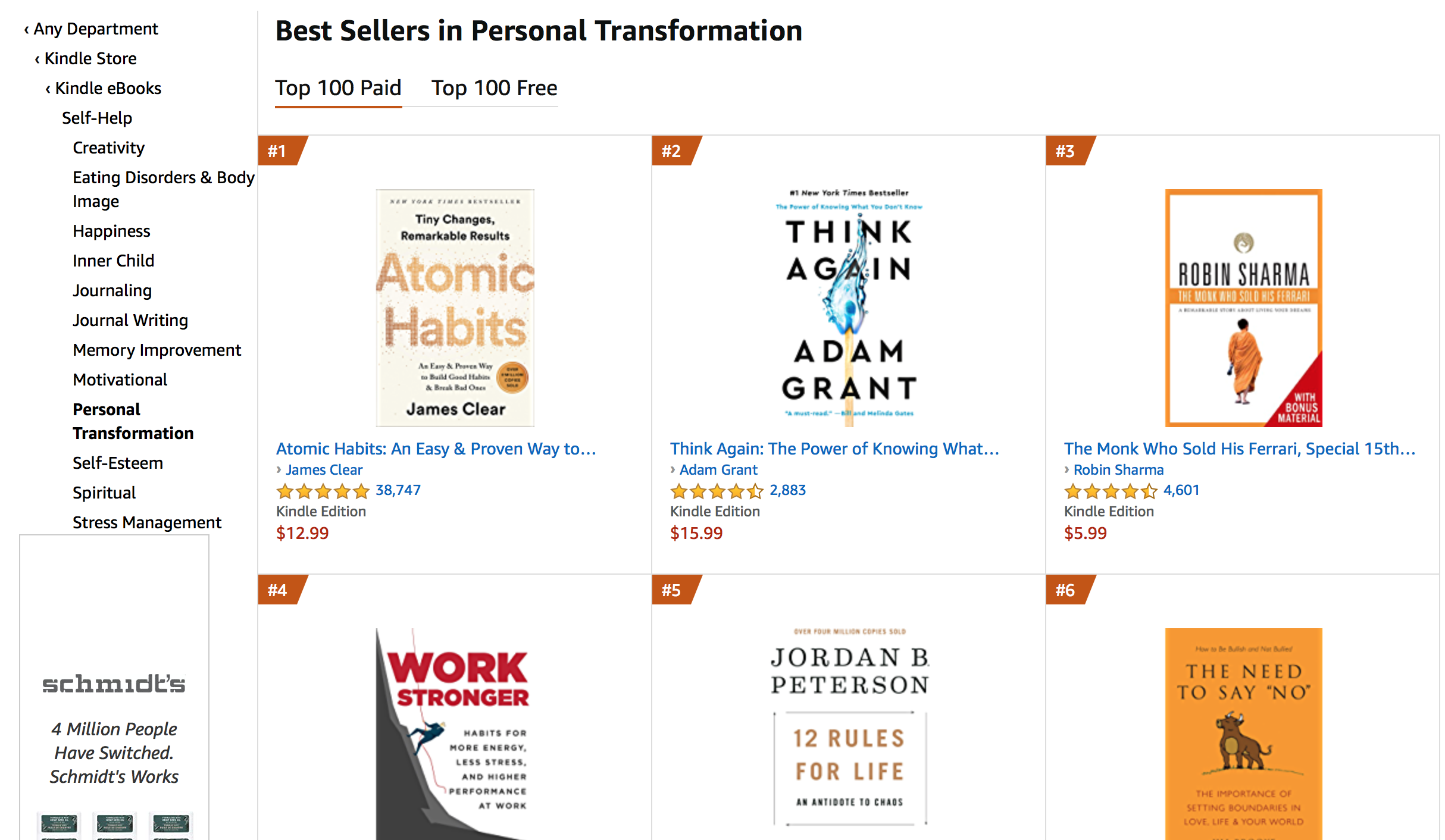
Now take the names you’re seeing here - you should know based on your niche research what names are more related to your audience – and put them in an excel document or just write them down.
Next, start typing in these author names in the interest-based targeting field on Ads Manager at the Ad Set level of a new Campaign. Remember – not every interest will appear and not every interest Facebook suggests will be hyper-relevant to your audience.
What leads to ads not performing well is when some just stack every interest they can think of and everything Facebook suggests.
You need to make sure these interests are laser-targeted to your niche before throwing money at them. Because if your audience isn’t interested, there is very little return on your investment.
I type in James Clear and Atomic Habits, and it doesn’t appear. Let’s try Think Again.
While that didn’t appear the author Adam Grant does appear. But how do we know if it’s the same person as the Amazon best selling author?
Click on suggestions.
We have a winner.
Every suggestion is related to professional or personal development.
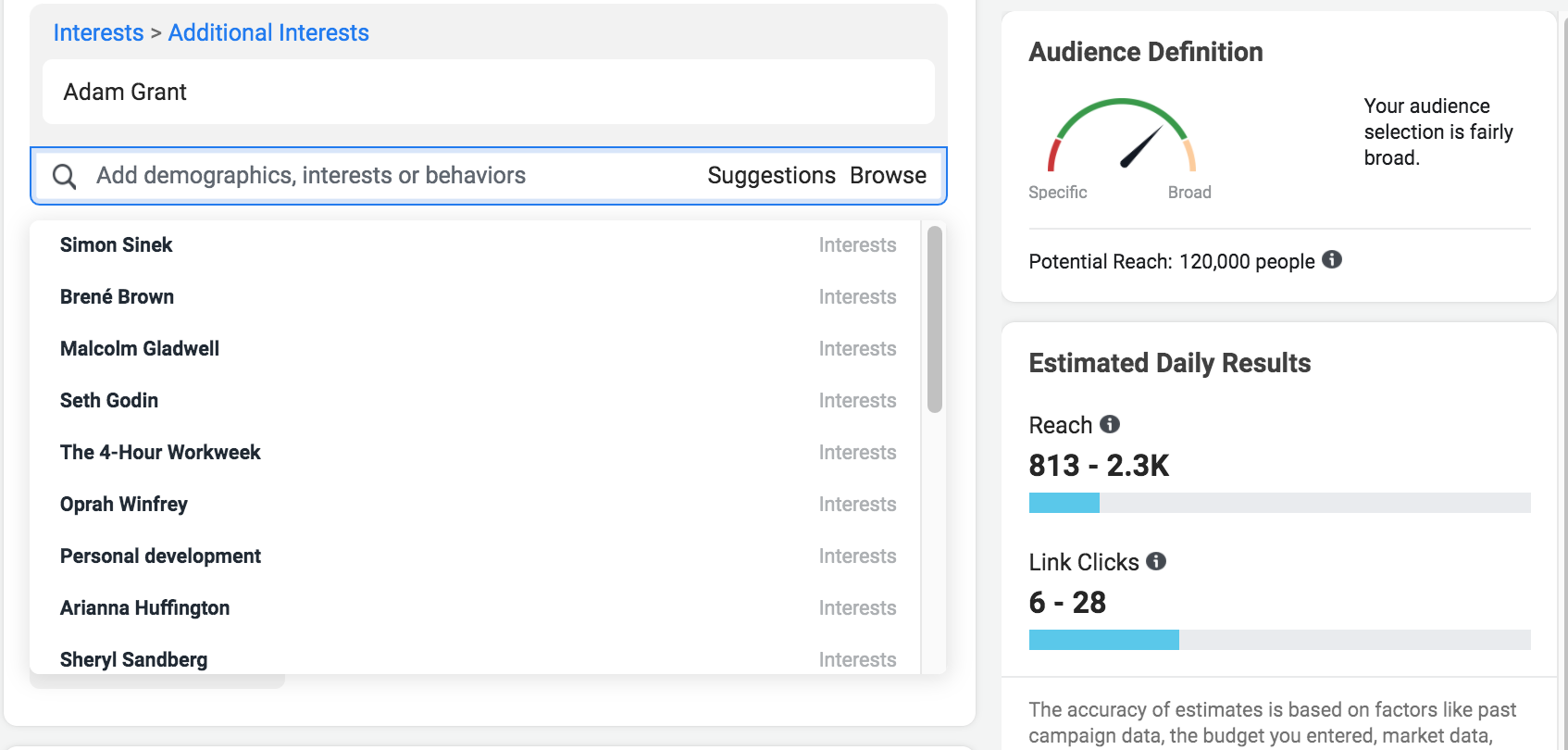
You’ll want to keep going until you have a few audiences created that you can split test for responsiveness.
The benefit of coming up with a large list of trending competitors is that you’re taking out the guesswork from targeting as patterns will emerge when you’re running AB tests.
The process of refining your audience who may consist of your competitors fans, is discovering which subniche outperforms the last.
Relying on large general audiences, you’re going to pay more in marketing costs because there’s more competition for fans of people like Tony Robbins since he’s a household name.
In order to get a better quality click you’ll create new segments of a larger audience that’s not seeing any ads like yours from your competitors. That’s where doing market research comes in handy.
Cross-referencing from Google, Amazon and Facebook helps to validate your ideas for the best client avatar and target audience.
The fact that they’re on Amazon best sellers lists AND show up in Ads Manager improves the quality of your customer profile for Facebook ads.
Now you can save this audience of Adam Grant fans, a subniche of Tony Robbins fans. You’ll want to keep doing this until you have a few audiences saved you can split test.
While the detailed interest-based targeting won’t show you all of the same demographic info that Facebook Audience Insights does, with this approach you can get better results at a lower cost than targeting the same general interests your competitors do.
It's part art, it's part science and a lot of split testing to find the best result.
Conclusion
Audience Insights going away will definitely be felt by many marketers who have relied on this tool to define their audiences.
Some may be concerned their ads won’t perform like they did before. Algorithm changes aside, there are definitely actions you can still take to refine your audience and increase your ads performance.
You can get access to some of the same info in Audience Insights in Ads Manager you just have to be more strategic in how you can tap into it.
While top professions of a Facebook Page’s fan base in Audience Insights isn’t a field in Business Suite, in Ads Manager there’s demographic fields for job roles you can access.
When you spend your money you want to make sure that it generates a return quickly. This comes from your market research not a fancy hack.
Make sure you’re creating audiences by first validating that your client avatar is actually who you want to target and that it is someone you can reach with Facebook ads.
It’s a good idea to write down the keywords and terms from best selling books in your niche as well as virtual summits and conferences.
Write down these interest-based targeting words you type in and that Facebook suggests. Put them in an Excel spreadsheet.
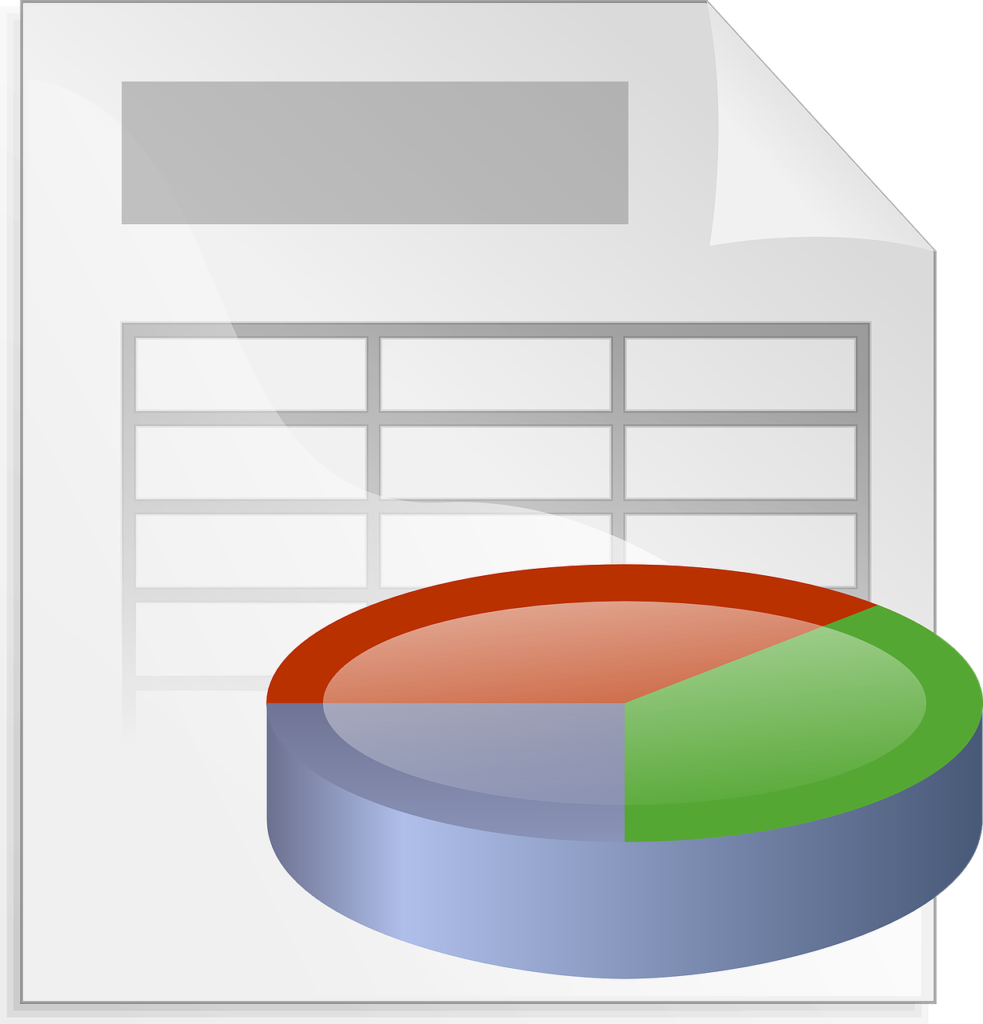
Then research those keywords to rule out which ones aren’t as relevant to your niche.
Repurpose these words inside of your Facebook ads and you’ll be on the right track to increase conversions.
Don’t forget we buy based on emotion not logic and that’s the power of offering a transformation that solves your audience’s pain points.
Creating new segments of larger audiences with a compelling offer will assist marketers in pivoting from Facebook’s removal of Audience Insights.
A compelling offer is something customers have to take action on. When you have it in front of the right people it works like gangbusters.
Of course you’ll want to run new ads, retarget potential buyers and do split testing.
Just make sure you also have a marketing funnel in place which is the conversion side of your advertising that turns them into leads and leads into customers. Facebook ads are the traffic side.
The key is to do more research than your competitors. It may seem like a chore but if that generates more revenue at a lower cost per click then the research pays for itself.
This isn’t because you’re doing anything magic; it’s because you’re putting in more work behind the scenes than 90-95% of the other advertisers on the Facebook ads platform.
They focus on the big easy-to-target audiences. You come in and do a little more research to find the lesser known segments that are still hyper relevant.
That is how you can find gold mines full of customers, leads and conversions at a very low cost to you in Facebook ad campaigns.
What do you think? What steps are you taking to plan for Audience Insights going away? Share your thoughts in the comments below.
New Solution to Facebook Ad Policy Violations
After years of working at Facebook, I understand exactly what ad copy in your funnel is triggering the automations and how to get compliant. I'm a Facebook ad policy specialist and can audit your funnel, and share what to say that Facebook wants to see instead - but just isn't telling you.
Stop guessing why Facebook shut you down and learn how to get your Facebook ads live again by scheduling a call with me here.
Want to book a call to talk to Facebook and get results? Get solid answers directly from the source instead of guessing, googling and playing roulette? Schedule a call with me and I can easily tell you proven reasons why the automations flag you and how to become compliant.
You'll be swapping out walking in a minefield of ad flags, to have a sure path to having your Facebook ad accounts protected from being disabled.
My clients have included social media marketing agencies of Tony Robbins, Harv Eker and Dean Graziosi. I'm featured on the Queen of Facebook Mari Smith's Marketing Essentials Course.
Save energy and money - how much is it costing you to not know why Facebook is shutting you down? I can save you that time and money click here.
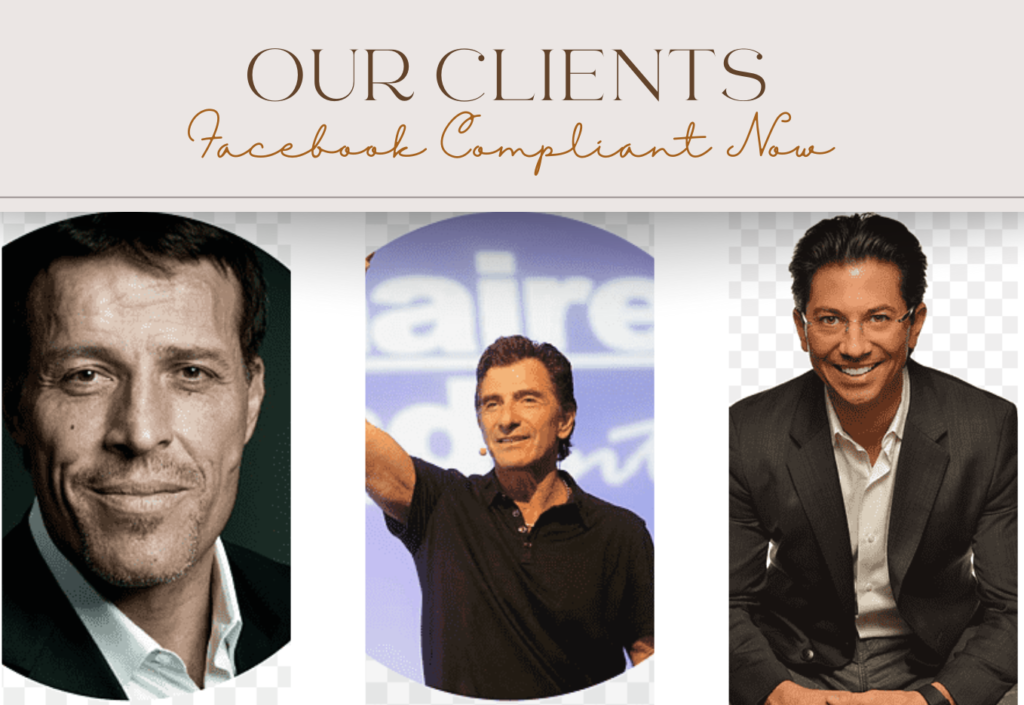
I get 100s of emails a week from businesses and advertisers asking for help when their facebook ad account keeps getting disabled, so my calendar gets booked fast. But if you want to get to the front, you can pre-pay for a consulting session here: Book a call
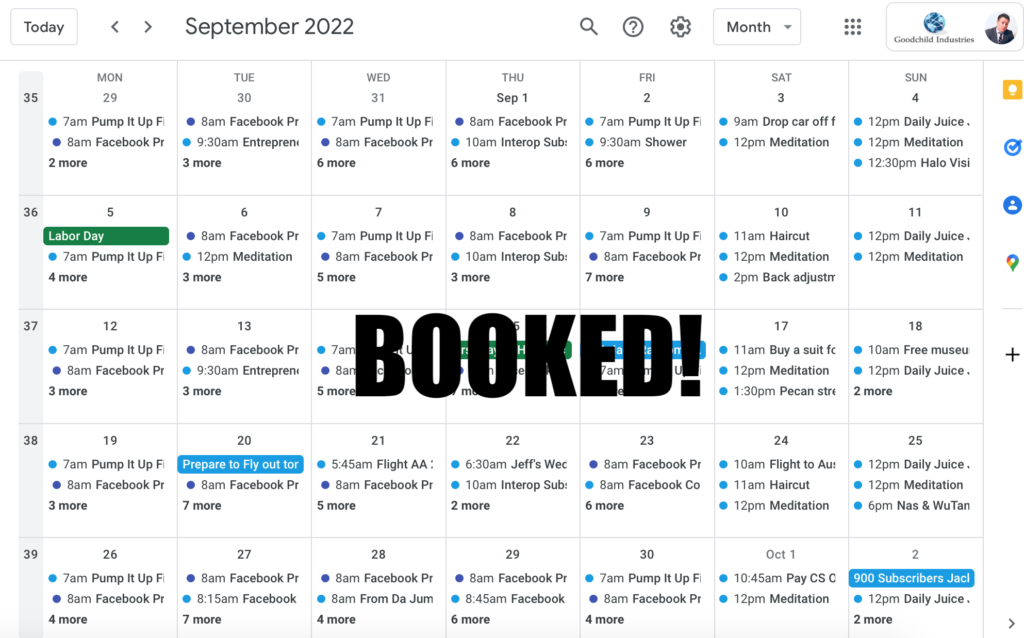
If you want to skip the line before this offer ends, immediately secure an expert-level Facebook consulting call from someone at Facebook. Book a call with me now!
If you're ok with waiting a bit longer, and entering the waitlist to see if you're eligible - Schedule a call or contact me via email.
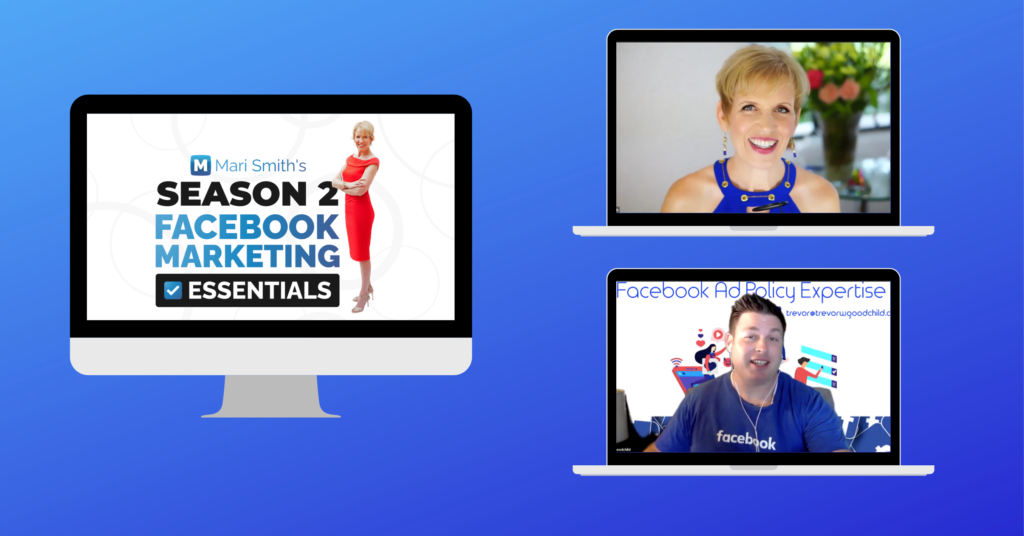
A few Tuesdays a month on Clubhouse 10am-12pm CST I host a Startup Club Room called Entrepreneurs That Make A Difference - follow me @fbpolicypro to find out more.
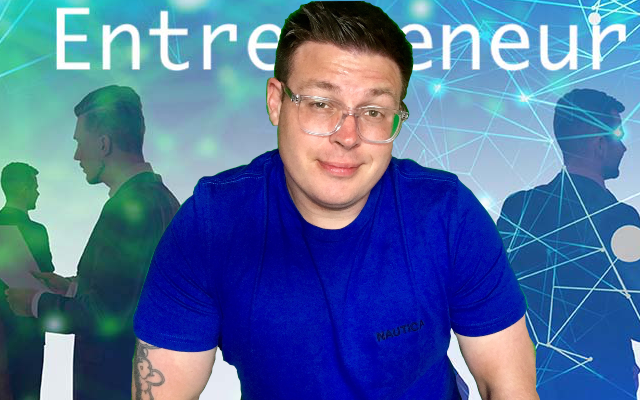
. . .





Great suggestions. Thanks for sharing!
Very good blog post. I absolutely appreciate this site. Thanks!
I appreciate the read!
Thanks!
Glad it helped!